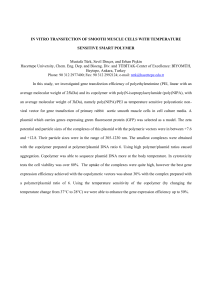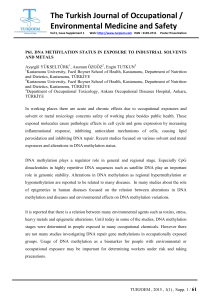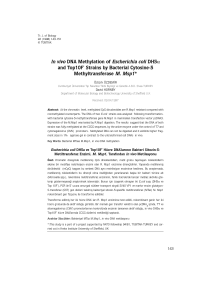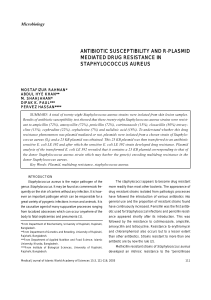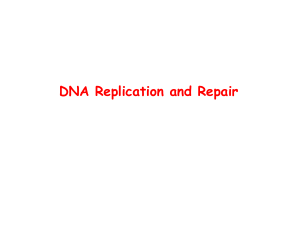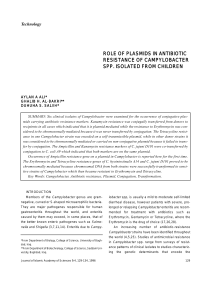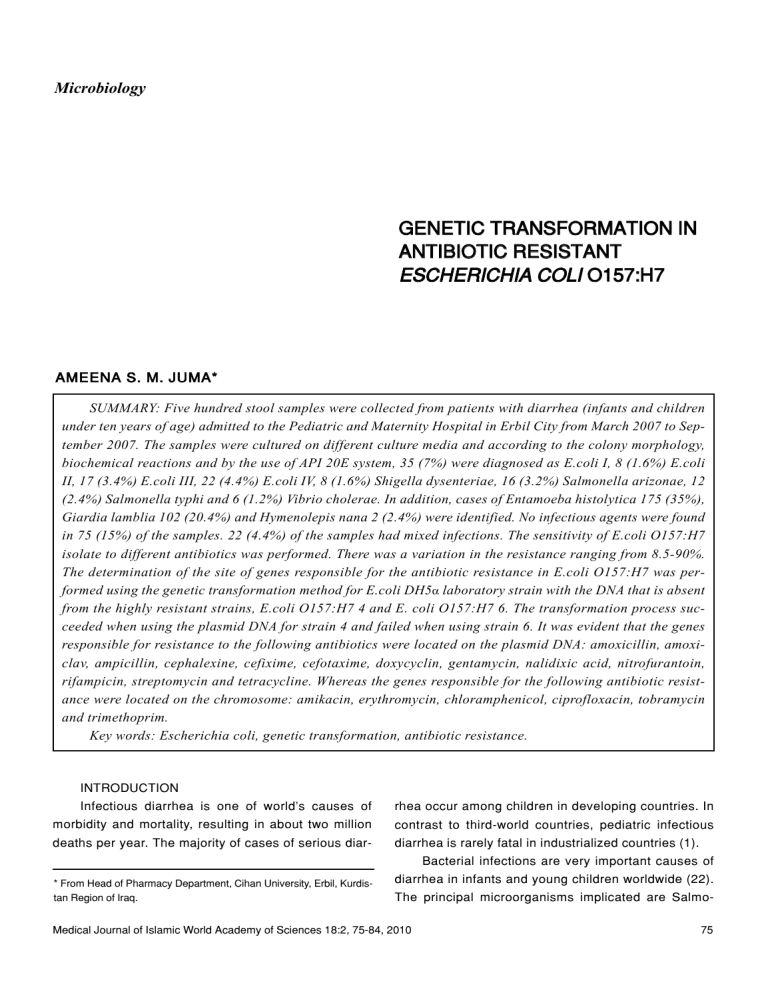
Microbiology
GENETIC TRANSFORMATION IN
ANTIBIOTIC RESISTANT
ESCHERICHIA COLI O157:H7
AMEENA S. M. JUMA*
SUMMARY: Five hundred stool samples were collected from patients with diarrhea (infants and children
under ten years of age) admitted to the Pediatric and Maternity Hospital in Erbil City from March 2007 to September 2007. The samples were cultured on different culture media and according to the colony morphology,
biochemical reactions and by the use of API 20E system, 35 (7%) were diagnosed as E.coli I, 8 (1.6%) E.coli
II, 17 (3.4%) E.coli III, 22 (4.4%) E.coli IV, 8 (1.6%) Shigella dysenteriae, 16 (3.2%) Salmonella arizonae, 12
(2.4%) Salmonella typhi and 6 (1.2%) Vibrio cholerae. In addition, cases of Entamoeba histolytica 175 (35%),
Giardia lamblia 102 (20.4%) and Hymenolepis nana 2 (2.4%) were identified. No infectious agents were found
in 75 (15%) of the samples. 22 (4.4%) of the samples had mixed infections. The sensitivity of E.coli O157:H7
isolate to different antibiotics was performed. There was a variation in the resistance ranging from 8.5-90%.
The determination of the site of genes responsible for the antibiotic resistance in E.coli O157:H7 was performed using the genetic transformation method for E.coli DH5α laboratory strain with the DNA that is absent
from the highly resistant strains, E.coli O157:H7 4 and E. coli O157:H7 6. The transformation process succeeded when using the plasmid DNA for strain 4 and failed when using strain 6. It was evident that the genes
responsible for resistance to the following antibiotics were located on the plasmid DNA: amoxicillin, amoxiclav, ampicillin, cephalexine, cefixime, cefotaxime, doxycyclin, gentamycin, nalidixic acid, nitrofurantoin,
rifampicin, streptomycin and tetracycline. Whereas the genes responsible for the following antibiotic resistance were located on the chromosome: amikacin, erythromycin, chloramphenicol, ciprofloxacin, tobramycin
and trimethoprim.
Key words: Escherichia coli, genetic transformation, antibiotic resistance.
INTRODUCTION
Infectious diarrhea is one of world's causes of
rhea occur among children in developing countries. In
morbidity and mortality, resulting in about two million
contrast to third-world countries, pediatric infectious
deaths per year. The majority of cases of serious diar-
diarrhea is rarely fatal in industrialized countries (1).
Bacterial infections are very important causes of
* From Head of Pharmacy Department, Cihan University, Erbil, Kurdistan Region of Iraq.
diarrhea in infants and young children worldwide (22).
The principal microorganisms implicated are Salmo-
Medical Journal of Islamic World Academy of Sciences 18:2, 75-84, 2010
75
JUMA
ANTIBIOTIC RESISTANT
nella (35), Shigella (34), Vibrio cholerae (37) and
The risk of E.coli O157:H7 occurs in its plasmid,
serotypes of Escherichia coli including EPEC, STEC,
because of its ability to transfer plasmids to other bac-
EAEC, EIEC and EHEC (26).
teria or other strains of E.coli by transformation, conju-
Antibiotic resistance has become a major clinical
gation and transduction processes (13). Genetic
and public health problem during the lifetime of most
transformation is a process by which free DNA is incor-
people (17). There are many reasons for this problem,
porated into a recipient cell and brings about genetic
one of which is an over use of antibiotics (36) in addi-
change (18).
tion to the chromosomal changes or the exchange of
The current study was conducted to study the
the genetic material via plasmid and transposons which
antimicrobial resistance of E.coli O157:H7 to different
help in transmission and spread of drug resistance
antibiotics and to determine the site of antimicrobial
among pathogenic bacteria (3).
resistance genes by genetic transformation.
Table 1: Standard antisera used through the study.
76
Standard antisera
Company
1
Anti Escherichia coli polyvalent I
O1, O26, O86a, O111, O119, O127a, O128
DENKA SEIKEN / Japan
2
Anti Escherichia coli polyvalent II
O44, O55, O125, O126, O146, O166
DENKA SEIKEN / Japan
3
Anti Escherichia coli polyvalent III
(Anti Escherichia coli O157)
Serotest / England
4
Anti Escherichia coli polyvalent IV
O6, O27, O78, O148, O159, O168
DENKA SEIKEN / Japan
5
Anti Escherichia coli H7
Serotest / England
6
Anti Shigella flexneri polyvalent (1-6)
Serotest / England
7
Anti Shigella sonnei polyvalent (1-6)
Serotest / England
8
Anti Shigella dysenteriae polyvalent (1-10)
Serotest / England
9
Anti Shigella boydii polyvalent (7-11)
Serotest / England
10
Anti Salmonella polyvalent O
Serotest / England
11
Anti Salmonella polyvalent H
Serotest / England
12
Anti Vibrio cholerae polyvalent O1
(Hikojima, Inaba, Ogawa)
RSHM / Turkey
13
Anti Vibrio cholerae O1 Ogawa
RSHM / Turkey
14
Anti Vibrio cholerae O1 Inaba
RSHM / Turkey
15
Anti Vibrio cholera polyvalent O139
RSHM / Turkey
Medical Journal of Islamic World Academy of Sciences 18:2, 75-84, 2010
JUMA
ANTIBIOTIC RESISTANT
MATERIALS AND METHODS
ence of RBC's, WBC's and parasites and their stages. The
Specimen collection and diagnosis
sample was then cultivated on suitable culture media (Mac-
A total of 500 stool samples were collected in clean dispos-
Conkey and blood agar {Oxoid, England}) and incubated at 37°C
able plastic containers from diarrheal patients (infants and chil-
overnight. The growing colonies were cultured on further selec-
dren, below ten years of age) admitted to the Pediatric and
tive and differential media and diagnosed using the API 20E
Maternity Hospital in Erbil City from March 2007 to September
system. The diagnosed bacteria were selected and transferred
2007 and the relevant information were recorded from each
to nutrient agar (Oxoid, England) slants and incubated at 37°C
patient including age, sex, geographical area, clinical symptoms
overnight. The slants were kept at 4°C until used. All bacterio-
and the type of feeding. Samples were then sent for direct
logical assays were performed according to Arora and Arora (6).
Diagnosis of bacterial isolates was confirmed using spe-
macroscopical and microscopical examination in the laboratory
of Maternity and Children Hospital to be checked for the pres-
cific anti-sera, as shown in Table 1.
Table 2: Antibiotics used (5, 14).
Antibiotics’ Names
Symbol
Stock Solution
(mg / ml)
Final (Working)
Concentration
µ(µg / ml)
Solvent
Amikacin
Amk
20
15
D.W.
Amoxicillin
Amc
25
25
D.W.
Ampicillin
Amp
50
50
D.W.
Augmentin
(Amoxicillin+Clavulanic acid)
Aug
10
30
Methanol
Cefixime
Cex
20
5
50% Methanol
Cefotaxime
Cef
10
30
D.W.
Cephalexine
Cep
45
30
D.W.
Chloramphenicol
Cm
34
30
Ethanol
Ciprofloxacin
Cip
10
5
D.W. and Ethanol
Doxycyclin
Do
10
30
D.W.
Erythromycin
Ery
10
10
Ethanol
Gentamycin
Gm
10
10
D.W.
Nalidixic acid
Nal
5
30
0.3M NaOH
Nitrfurantion
Nit
30
10
Dimethylformamide
Rifampicin
Rif
34
5
Methanol + 5 drops of
10N NaOH / ml
Streptomycin
Sm
10
25
D.W.
Tetracycline
Tc
5
15
50% Ethanol
Tobramycin
To
10
30
D.W.
Trimethoprim-sulfamethoxazole
Tm
20
20
Dimethylformamide
Medical Journal of Islamic World Academy of Sciences 18:2, 75-84, 2010
77
JUMA
ANTIBIOTIC RESISTANT
Antibiotic resistance test
strain of E. coli DH5α (it is a bacterial strain that does not con-
To study the effect of different antimicrobials on E.coli
O157:H7, both nutrient (Oxoid, England) and Mueller-Hinton
tain the plasmid used in this study and is a derivative of E.coli
K-12, kindly provided by Dr. Farhad Abdulkareem from Erbil).
agar (HHI MEDIA/ India) were used as growth media, after
sterilization and cooling at 45°C, final concentration of antibi-
Transformation process includes
otics was added (Table 2) to media and poured into sterile Petri
1. Preparation of competent cells
dishes. After solidification, the plates were inoculated by
They were prepared by the method described by Mandle
streaking method with the bacterial isolate then incubated at
and Hige (19). Five ml of nutrient broth was inoculated with a
37°C for 24 hours. The results were recorded the next day (4).
single colony of E.coli DH5α (whose plasmid is manipulated
genetically, plasmidless), incubated with shaking at 100 rpm
Genetic transformation
for 24 hours at 37°C then 1ml of bacterial culture was added to
To determine the location of antibiotic resistance gene in
50 ml nutrient broth, incubated with shaking at 37°C, 100 rpm
E.coli O157:H7 the purified plasmid from E.coli O157:H7
for 3-4 hours. The cells were harvested by centrifugation at
(resistant to antibiotics) was transformed to another sensitive
800 rpm, and then resuspended in 1 ml of cooled transforma-
Table 3: Enteropathogens detected in fecal samples from 500 children with diarrhea
Type of Enteropathogen
78
Number
Percentage (%)
E.coli polyvalent I
35
7
E.coli polyvalent II
8
1.6
E.coli polyvalent III
17
3.4
E.coli polyvalent IV
22
4.4
Shigella dysenteriae
8
1.6
Salmonella arizonae
16
3.2
Salmonella typhi
12
2.4
Vibrio cholerae
6
1.2
Entamoeba histolytica
175
35
Giardia lamblia
102
20.4
Hymenolepis nana
2
0.4
No pathogen identified
75
15
Mixed infection (E.coli polyvalent III + E.coli polyvalent I {12},
Salmonella typhi + E.coli polyvalent III {7}, Salmonella typhi +
E.coli polyvalent III {3})
22
4.4
Total
500
100
Medical Journal of Islamic World Academy of Sciences 18:2, 75-84, 2010
JUMA
ANTIBIOTIC RESISTANT
tion buffer (TE buffer), then 39 ml of the same buffer added, the
Table 4: Percent of resistance to antimicrobials of E.coli O157:H7
resuspended cell left on ice for one hour, centrifuged for 15
isolated from stool samples of patients with diarrhea.
minutes at the same velocity, and resuspended in 1ml of
cooled transformation buffer. To increase the efficiency of
Antibiotics at final concentration*
E. coli polyvalent III
Amk
S
2. DNA uptake
Amc
89
The method of Lederberg and Cohen (16) was used for
Amp
90
Aug
88
agar plates and incubated at 37°C for 24 hours to ensure that
Cex
35
they are not contaminated with the bacterial cells. 1µg of pre-
Cef
35
Cep
80
Cm
S
Cip
28
minutes to allow the expression of antibiotic resistant genes.
Do
42
Five samples of (0.1ml) from transformation mixture were
Ery
35
Gm
18
Nal
10
Nit
8.5
Rif
29
Sm
52
Tc
70
To
45
Tm
8.3
genetic transformation, the competent cells were kept at 4°C
for 24 hours before adding the plasmid.
uptake of plasmid DNA for the process of transformation. Samples of 0.1ml of prepared plasmid DNA were plated on nutrient
pared plasmid DNA (equivalent to 100µl) was added to the
tube containing 0.2 ml of competent cells. The mixture was
placed on ice for 30 minutes, and then exposed to heat shock
at 42°C for 6 minutes (12). 1ml of fresh nutrient broth was then
added to transformation mixture and incubated at 37°C for 60
spread on nutrient agar plates containing the appropriate
antibiotic, and 0.1 ml of competent cells was spread on nutrient
agar containing the same antibiotics used as a control. All
plates were incubated at 37°C for 48 hours. The number of
transformation colonies were scored and purified several times
on plates containing the different antibiotics used.
The genetic transformation frequency was calculated following the equation described by Puhler and Timmis (23):
Transformation Frequency = Number of transformation
colonies per µg of plasmid DNA / Number of viable cells
Statistical analysis
The data were analyzed using the ANOVA test.
S: Sensitive
*Abbreviations of antibiotics are in Table (2)
RESULTS
The causative agents of diarrhea are presented in
transformant colonies produced by the plasmid DNA
Table 3. The most common isolated enteropathogens
was less than the original number. The number of
were Entamoeba histolytica, bacteria and Giardia lam-
transformant colonies obtained was 248 and then
blia. The difference between these groups was signifi-
became 100 colonies when sub cultured on Amoxicillin,
cant (P ≤ 0.05).
Amoxiclave,
Nalidixic
acid,
Nitrofurantoin
and
There was variation in the resistance to antibiotics
Rifampicin at appropriate concentrations. Forty-three,
of the isolate E.coli O157:H7 ranging from 8.5-90%
70, 56, 20, 13, 23, 53 and 76 colonies were obtained
whereas other isolates were sensitive (Table 4).
for Ampicillin, Cefalixine, Cefixime, Cefotaxime, Doxy-
Table 5 shows that E.coli DH5 α had the ability to
cylcin, Gentamycin, Streptomycin and Tetracycline,
receive purified E.coli O157:H7 plasmid DNA and
respectively. Transformation frequency for E.coli
transformed successfully. The number of the purified
O157:H7 was 7.02 X 10-7.
Medical Journal of Islamic World Academy of Sciences 18:2, 75-84, 2010
79
JUMA
ANTIBIOTIC RESISTANT
E.coli
O157:H7
4
No. of transformant colonies
Isolate
Table 5: Number of transformation colonies and transformation frequency of E.coli O157:H7 isolated from stool of patients with diarrhea.
248
Transformation
frequency
Number of colonies grown on nutrient agar containing antimicrobials in µg/ml
Amk* Am Aug Amp Cep Cex
S
E.coli
O157:H7
6
100 100
43
70
56
Cef Cm Cip Do Ery Gm Nal Nit
20
S
S
13
S
Rif
Sm Tc To Tm
23 100 100 100 53
76
s
s
7.02 x 10-7
Transformation did not succeed after repeating the process several times
All 100 controls were investigated for E.coli
DISCUSSION
The predominant causes of diarrhea in the stool of
(serotypes) and none were positive. 17 (3.4%) were
patients enrolled in this study were parasites and bac-
E.coli Polyvalent III. These results were found to differ
teria, while other etiological causes or organisms were
from the results of Sulaiman (33) who isolated polyva-
of less significance which may be because of their
lent III at a rate of 37.5% of 40 isolates, in Erbil City.
need for special media and growth conditions for isola-
Our results, on the other hand, were similar to those
tion including Yersinia and Campylobacter (13).
reported by Shebib et al. (32) who identified the rate of
All 100 controls were investigated for E.coli
STEC in 11.5%. The differences in the results may be
(serotypes) and none were positive. 17 (3.4%) were
due to the use of better methods for isolation and iden-
E.coli Polyvalent III. These results were found to differ
tification in our current study in addition to the fact that
from the results of Sulaiman (33) who isolated polyva-
pathogenic E.coli is an important etiological agent in
lent III at a rate of 37.5% of 40 isolates, in Erbil City.
infants with diarrhea in Erbil City (24, 33).
Our results, on the other hand, were similar to those
E.coli O157:H7 was found to be sensitive to Amk
reported by Shebib et al. (32) who identified the rate of
and Cip. On the other hand, it was found to be resistant
STEC in 11.5%. The differences in the results may be
to all other antibiotics, ranging from 8.5%-90%. How-
due to the use of better methods for isolation and iden-
ever, ciprofloxacin and other quinolones are not
tification in our current study in addition to the fact that
approved for children because of the risk of damage to
pathogenic E.coli is an important etiological agent in
immature joints and most parental third-generation
infants with diarrhea in Erbil City (24, 33).
cephalosporins (e.g. cefotaxime) are administered only
The predominant causes of diarrhea in the stool of
in a hospital setting. These results are also similar to
patients enrolled in this study were parasites and bac-
those of Salah (29) who showed all isolates of E.coli to
teria, while other etiological causes or organisms were
be resistant (97.5%) for Cm and less resistant for Amk
of less significance which may be because of their
(2%).
need for special media and growth conditions for isolation including Yersinia and Campylobacter (13).
80
Sang et al. (31) study reported multidrug-resistance in enteroaggregative E.coli with persistent diar-
Medical Journal of Islamic World Academy of Sciences 18:2, 75-84, 2010
JUMA
ANTIBIOTIC RESISTANT
rhea in Kenyan children where the isolates were resist-
less than that started from, where the number of the
ant to Tc and Aug. Another study (25) recorded the
transformant colonies obtained were 248 and became
highest rates of resistance against Amc, Cm, Tc and
100 colonies when sub-cultured on Amc, Aug, Nal and
Cip (100%) and the most common resistance pattern
Rif at appropriate concentrations, and 76, 70, 56, 53,
was for Amc, Gm, Cip, Tc, Cm (38.7%) and the least
43, 23, 20 and 12 colonies for Tc, Cep, Cex, Sm, Amp,
common resistance patterns was for Nit (3.2%).
Gm, Cef and Do, respectively.
The United States food and drug administration
Differences
were
observed
in
transformant
emphasizes the spread of drug resistance in the Enter-
colonies number for E4 isolates when cultured on dif-
obacteriaceae family from antibiotic-fed animals to
ferent antibiotics separately indicating that the antibi-
human beings. Transmission of the R-plasmid from
otics resistance genes are located on different
E.coli of poultry to humans occurs very commonly (25).
R-plasmid. This consists of two linking fragments, one
Antibiotic resistant E.coli may also pass on the genes
called RTF-TC, which carries several numbers of
responsible for antibiotic resistance to other species of
genes which are specialized for plasmid replication
bacteria, such as S.aureus and E.coli, often carry mul-
process and copy number of plasmids and sometimes
tidrug resistant plasmids and under stress readily
contain genes responsible for Tc resistance. The other
transfer those plasmids to other species. Indeed, E.coli
fragment is called r-determinant, which contains genes
is frequent member of biofilms, where many species of
responsible for other antibiotic resistance (7). These
bacteria exist in close proximity to each other. This
two DNA fragments of R-plasmid may enter the DH5 α
mixing of species allows E.coli strains that are piliated
host in different efficiency because of their variation in
to accept and transfer plasmids from and to other bac-
size. In addition, it is reasonable to believe that there is
teria. Thus E.coli and other enterobacteria are impor-
more than one DNA species of plasmid DNA content on
tant reservoirs of transferable antibiotic resistance (38).
isolate E4 and transformed in different efficiencies.
This variation in antibiotic resistance on E.coli is
Irregular segregation of plasmid DNA species may
due to the genes that are located on conjugant plasmid
result in differences in the number of transformant
and by conjugation, transformation or transduction
colonies for other antibiotics (11). Furthermore, irregu-
processes, may be transferred to recipient E.coli; or the
lar segregation of plasmid DNA species may result in
resistance genes may be located on bacterial chromo-
differences in the transformant colonies for other antibi-
some and jump to resistance plasmid by transposition
otics. On the other hand, the transformant colonies
process (many composite transposons contain genes
failed to grow on nutrient agar with Amk, Cm, Cip, Ery,
for antibiotic resistance and some bear more than one
To, Tm. This finding may be related to those genes
resistance gene). This is found in both Gram-negative
which are responsible for resistance to these antibi-
and Gram-positive bacteria (39).
otics, either located on chromosome or on large plas-
Genetic transformation experiment was performed
to determine the site of genes that are responsible for
mid which cannot enter DH5 α strain, acting as a host,
or have transposition property (29).
antibiotic resistance in E.coli O157:H7 isolates. Table 5
Isolated plasmid DNA from E6 isolate was not suc-
showed that E.coli DH5 α had received purified E.coli
cessfully transferred even after repeating the transfor-
O157:H7 plasmid DNA from E4 isolate and transformed
mation process several times. The large size of the
successfully, while the plasmid DNA sample for isolate
plasmid may have been exposed to the breakage
E6 failed to enter the host DH5α by the transformation
during its preparation. This could be considered as a
process after repeating the process several times. It is
reason for the failure of transformation of this isolate
also evident that the number of the purified trans-
(11).
formed colonies produced by the plasmid DNA were
Medical Journal of Islamic World Academy of Sciences 18:2, 75-84, 2010
Al-Atraqchi (2) recorded the location of the antibi81
JUMA
ANTIBIOTIC RESISTANT
otics Amp, Amc, Cep, Cm, Cip, Ery, Gm, Nal, Rif and Tc
0.8 X 10-4, 1.9 X 10-4, 1.6 X 10-4, 1.3 X 10-4 and 2.8 X
genes on the plasmid DNA by the genetic transforma-
10 -4 for E1, E2, E3, E4 and E5, respectively. While
tion of the strain E.coli : K12JM83 with plasmid DNA
Kheder (15) recorded 0.39 X 10 -8, 0.16 X 10 -8, 3.9 X
purified from E.coli, while Tm gene, Sm and Neo were
10-8, 0.2 X 10-8, 0.61 X 10-8, 0.067 X 10-8 and 3.3 X 10-
located on chromosomal DNA of E.coli . This is in
8
agreement with our results. In addition, Salah (29)
P31, P38, P40, and P51, respectively. Mawlud (20)
determined the location of genes responsible for antibi-
recorded 0.3 X 10-5 and 0.5 X 10-7 for Klebsiella pneu-
otic resistance in E.coli isolates Amk, Do and Tc
moniae isolates K11 and K32, respectively. Hamasalih
located on plasmid DNA. This is also comparable to our
(10) recorded 6.94 X 10-7 for P.aeruginosa isolate P5.
results. Cm, To, and Tm genes were located on plasmid DNA. These data disagree with our results.
on Pseudomonas aeruginosa isolates P7, P14, P28,
The transformation frequency differs from one type
of bacteria to another. These differences may be due to
Since the original recognition of transposon Tn1
the size and shape of transferred plasmid; small circle
carrying an ampicillin resistant determinant on plasmid
plasmids are transferred much more efficiently than
RP4, many other transposons have been reported
large circle plasmids in addition to the fact that the purity
among members of Enterobacteriaceae such as Tn2,
of plasmid affects transformation. We can conclude that
Tn3 , Tn21, Tn401, Tn903, Tn1701, and Tn2601. All of
the laboratory E.coli HD5α strains treated with CaCl2
these transposons carry the penicillinase (β-lactamase)
can represent an efficient host for accommodation of the
genes (40).
plasmid DNA transfer of E.coli O157:H7. In addition, the
Dale and Park (9) observed that the plasmid
preparation of plasmid DNA by Cesium chloride-ethid-
R100, which confers resistance to 4 different antibiotics
ium bromide centrifugation can increase the transforma-
Tc, Cm, Sm, and sulphonamides as well as to mercury
tion frequency because this procedure made plasmid
salts, carries two copies of IS1 and two copies of IS10.
DNA remains in (ccc) state (11).
They mentioned that the TEM β-lactamase is the most
Transformation frequency is influenced by several
common type amongst plasmids in the Enterobacteri-
factors like size of plasmid DNA. Although the size of
aceae and in many members of genus Pseudomonas.
plasmid DNA is small, the transformation frequency
Al-Atraqchi (2) detected the transposition property
becomes high or increased which means that the small
among some antibiotic resistance genes and the
size of plasmid DNA leads to genetic transformation to
results demonstrate that isolate 52 E.coli , 20 Mor-
be successful. Another factor is the purity of plasmid
ganella and 88 Salmonella contain transposons for
DNA which has a high effect on genetic transformation.
neomycin and streptomycin resistance. These genetic
Whenever plasmid DNA is in a high degree of purity,
transposable elements have the ability to jump from the
the genetic transformation is increased. Moreover,
chromosome of these isolates to plasmid DNA and
energy which is needed for adherence of the plasmid
integrate into genes encoding antibiotic resistance.
DNA to the competent cell is considered as a factor on
This result agrees with To, Tm, Ery, and Cm results
energy pathway of competent cells leading to preven-
which were located on chromosomal DNA in this study.
tion of the ability of plasmid DNA to enter (8, 30).
These plasmids responsible for antibiotic resistance
may have jumped to chromosomal DNA.
CONCLUSION
Transformation frequency for the E4 isolate was
1. High prevalence of Entamoeba histolytica and
7.02 X 10-7. The result of Al-Atraqchi (2) on K.oxytoca
Giardia lamblia that cause diarrhea followed by E.coli
31, E.coli 7, E.coli 97, M.morgana 20 and Salmonella
serotypes, Salmonella spp., Shigella and Vibrio cholerae.
88, were 2.2 X 10-5, 3.4 X 10-6, 0.063 X10-6, 0.96X10-7
2. Enteropathogenic E.coli (EPEC) is considered
and 1.2 X 10 -6, respectively. Mohamed (21) recorded
as one of the major causative agents of children's diar-
82
Medical Journal of Islamic World Academy of Sciences 18:2, 75-84, 2010
JUMA
ANTIBIOTIC RESISTANT
rhea followed by ETEC, STEC and EAggEC.
3. The isolated E.coli O157:H7 revealed high
resistance to most widely used antibiotics.
4. The genes responsible for Amc, Aug, Amp,
Cep, Cex, Cef, Do, Gm, Nal, Nit, Rif, Sm and Tc resist-
ance in E.coli O157:H7 are located on plasmid DNA,
and others including Amk, Cm, Cip, To, Ery and TM are
located on chromosomal DNA. These genes are successfully transferred to laboratory E.coli DH5α strains
through transformation process.
REFERENCES
Taiwanese university hospital. J Antimicrob Chemother, 49:69-76,
1. Afset JE, Bergh K, Bevanger L: High prevalence of a typi-
2002.
15. Kheder AK: Studies on antibiotic resistance by plasmids
cal enteropathogenic Escherichia coli (EPEC) in Norwegian children with diarrhea. J Med Microbiol, 52:1015-1019, 2003.
2. Al-Atraqchi KIB: Molecular genetic studies of bacterial
of Pseudomonas aeruginosa. Ph.D. Thesis, College of Education,
University of Salahaddin, Erbil-Iraq, 2002.
16. Lederberg EM, Cohen SN: Transformation of S.
species isolated from patients with diarrhea. Ph D Thesis. College
of Medicine Hawler, Medical University, Erbil, Iraq, 2006.
3. Al-Faisal, A: Genetic Engineering. Dar Al-Shrooq for Pub-
typhimurium by plasmid Deoxyribonucleic acid. J Bacteriol, 119:
1072-1074, 1974.
17. Levy SB: Active efflux, a common mechanism for bicid
lishing Amman (Arabic), 1999.
4. Al-Najjar AR: Studies on the effect of surfactants on the
antimicrobial activity of several antibiotics. Ph.D. Thesis, Univer-
and antibiotic resistance. J Appl Microbiol Symp, Suppl 92:65-71,
2002.
18. Madigan MT, Martinko JM, Parker J: Brock Biology of
sity of Manchester, UK, 1976.
5. Andrews JM: Determination of minimum inhibitory con-
Microorganisms, 9th ed. Prentice-Hall, Inc. USA, 2000.
19. Mandle M, Hige A: Calcium-dependent bacteriophage
centrations. J Antimicrob Chemother, 482: 5-16, 2001.
6. Arora B, Arora DR: Practical Microbiology. CBS Publish-
DNA infection. J Mol Biol, 53:159-161, 1970.
20. Mawlud SQ: The effect of some medicinal plant extracts
ers and Distributors, New Delhi, 2007.
7. Clows R: Molecular structure of bacterial plasmids. Bact
Rev, 36: 361, 1972.
8. Cosloy SD, Oishi M: Genetic transformation in E. coli: K-
on curing plasmids of Klebsiella pneumoniae isolates from different environments. M.Sc. Thesis, College of Education University
of Salahaddin, Erbil-Iraq, 2006.
21. Mohamed BG: Genetic study of Escherichia coli isolated
12. Practice of National Academics Science, USA. 70: 84-86,
from various human infections. M.Sc. Thesis, College of Educa-
1973.
9. Dale W, Park S: Molecular genetics of bacteria. 4th ed,
tion, University of Mosul (Arabic), 1999.
22. Nelson EW, Berhman ER, Kligman MR, Jenson: Nelson
John Wiley and Sons Ltd, England, 2004.
10. Hamasalih RM: The effect of both aqueous and alcoholic
extracts of Quercus infectoria against antibiotic resistance of
Textbook of Paediatrics. 15th ed, Vol1. WB Saunders, USA. pp
935-1123, 2004.
23. Puhler A, Timmis NK: Advances in Molecular Genetics.
Pseudomonas aeruginosa In vitro and In vivo studies. M.Sc.
Thesis, College of Education, University of Salahaddin, Erbil-Iraq,
Springer-Verlag, Berlin, 1984.
24. Rasheed NE: Etiology of bloody diarrhoea among chil-
2008.
11. Hardy K: Bacterial plasmid. 2nd ed, Am Soc Microbiol,
USA, 1986.
12. Hoekstra WM, Bergman HN, Zuidweg EM: Transforma-
dren admitted to maternity and children hospital. Diploma of Science in Paediatrics, College of Medicine, University of Salahaddin,
2003.
25. Roy R, Purushothaman V, Koteeswaram D, Dhillon AS:
tion in E.coli, studies on the nature of donor DNA after uptake and
interaction. Genetic Res Comb, 35:281-285, 1980.
13. Jawetz E, Melnick JL, Adelberg EA, Brooks GF, Butel
JS, Morse SA: Medical Microbiology. 23rd ed, McGraw-Hill, USA,
Isolation, characterization and antimicrobial drug resistance pattern of E.coli isolated from Japanese quail and their environment.
Jappel poultres, 15: 442-446, 2006.
26. Ruohonen P: Other strains of E.coli outbreak. Pritzker
2004.
14. Jean SS, Teny LJ, Hsueh PR, HO SW, Luh KT: Antimi-
Law Firm, 2008.
crobial susceptibilities among clinical isolates of extended-spec-
29. Salah HF: Effect of some medicinal plant extracts on
trum cephalosporin, resistant Gram-negative bacteria in a
antibiotic resistance by plasmid of Escherichia coli isolated from
Medical Journal of Islamic World Academy of Sciences 18:2, 75-84, 2010
83
JUMA
ANTIBIOTIC RESISTANT
different sources. M.Sc. Thesis, College of Education, University
Bacteriology, 2005.
of Salahaddin, 2007.
36. Webster M: Antibiotic resistance in E.coli. Hastings-on-
30. Salle AJ: Fundamental Principle of Bacteriology. 7th ed.
Hudson. High School, Westchester, 2002.
McGraw-Hill Book Company, USA, 1997.
37.
31. Sang WK, Oundo JO, Mwituria JK, Waiyaki PG, Yoh M;
Iida
T,
Honda
T:
Multidrug-resistant
entero
aggregative
Escherichia coli associated with persistent diarrhea in Kenyan
Wikipedia:
Cholera,
Wikipedia
foundation,
Inc.
http://en.wikipedia.org/org/cholera, 2008.
38. Wikipedia: Escherichia coli. Wikipedia foundation, Inc,
2008.
children. Emerging Infect Dis, 3(3), 1997.
39. Woodford N, Johnson AP: Molecular bacteriology, proto-
32. Shebib Z, Abdulghani Z, Mehdi L: First report of E.coli
cols and clinical application. Humana Press Inc, 1998.
O157 among Iraqi children. East Mediterr Hlth J, 9: 1-8, 2003.
40. Yamamoto T, Tanako M, Nohra C: Transposition of the
33. Sulaiman SS: The identification, serological, classification, heamagglutination makers and antibiotic sensitivity patterns
oxacillin hydrolyzing penicillinase gene. J Bacteriol 145: 808-813,
1981.
in Escherichia coli causing infantile gastroenteritis in Erbil. M.Sc.
Thesis, College of Science, University of Salahaddin. (Arabic),
1994.
34. Sureshbabu J: Shigella infection. Honcode principles of
the health of the net foundation. Web MD, 2006.
35. Todar K: Salmonella and Salmonellosis, University of
Wisconsin-Madison, Dept Bacteriol Todar's online textbook of
84
Correspondence:
Ameena S. M. Juma
Head of Pharmacy Department,
Cihan University, Erbil,
Kurdistan Region of Iraq.
e-mail: pharmacy.cihan@yahoo.com
Medical Journal of Islamic World Academy of Sciences 18:2, 75-84, 2010

